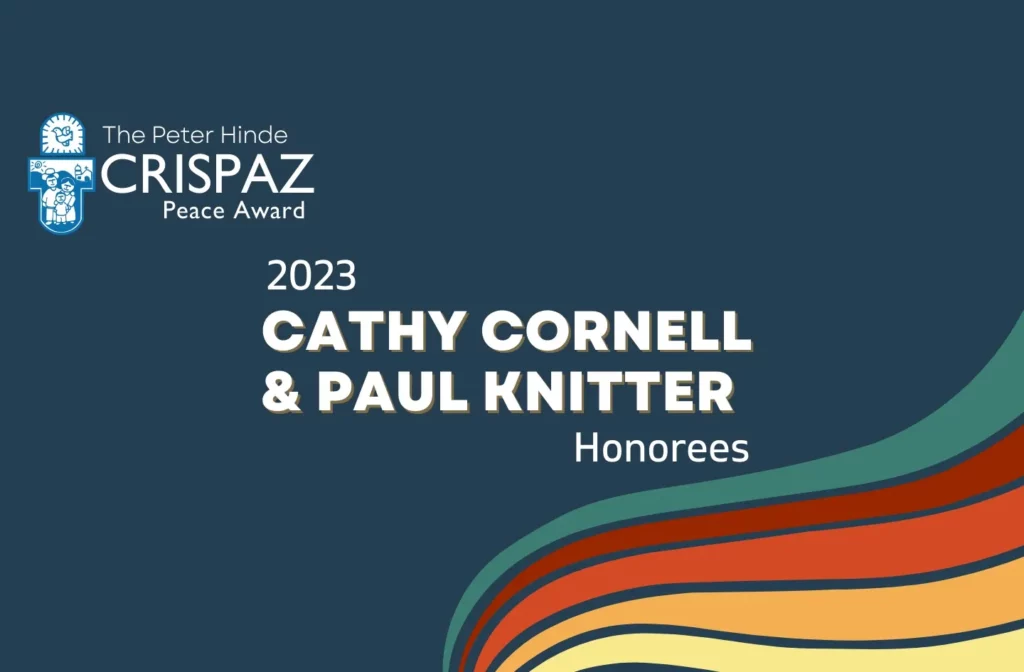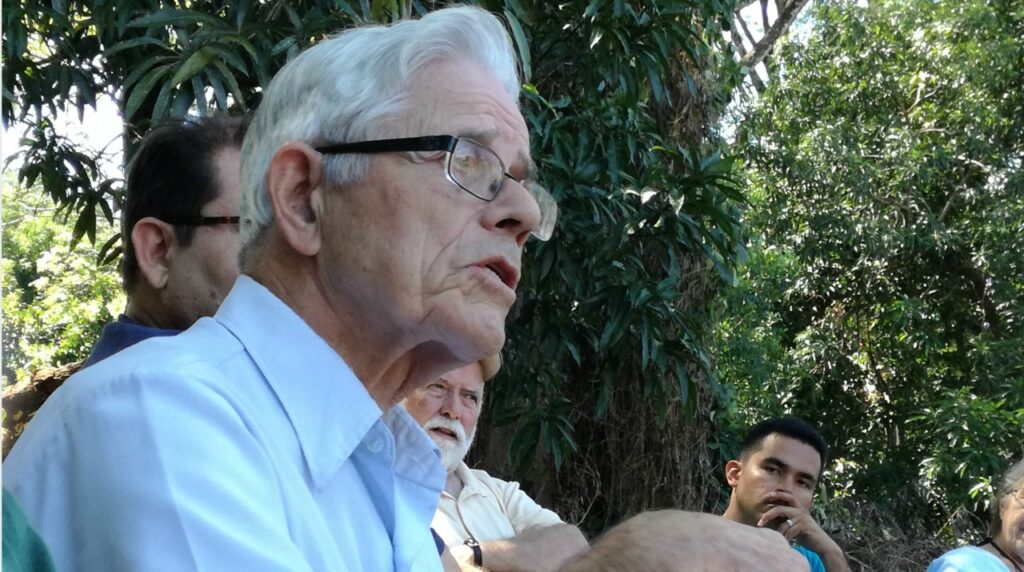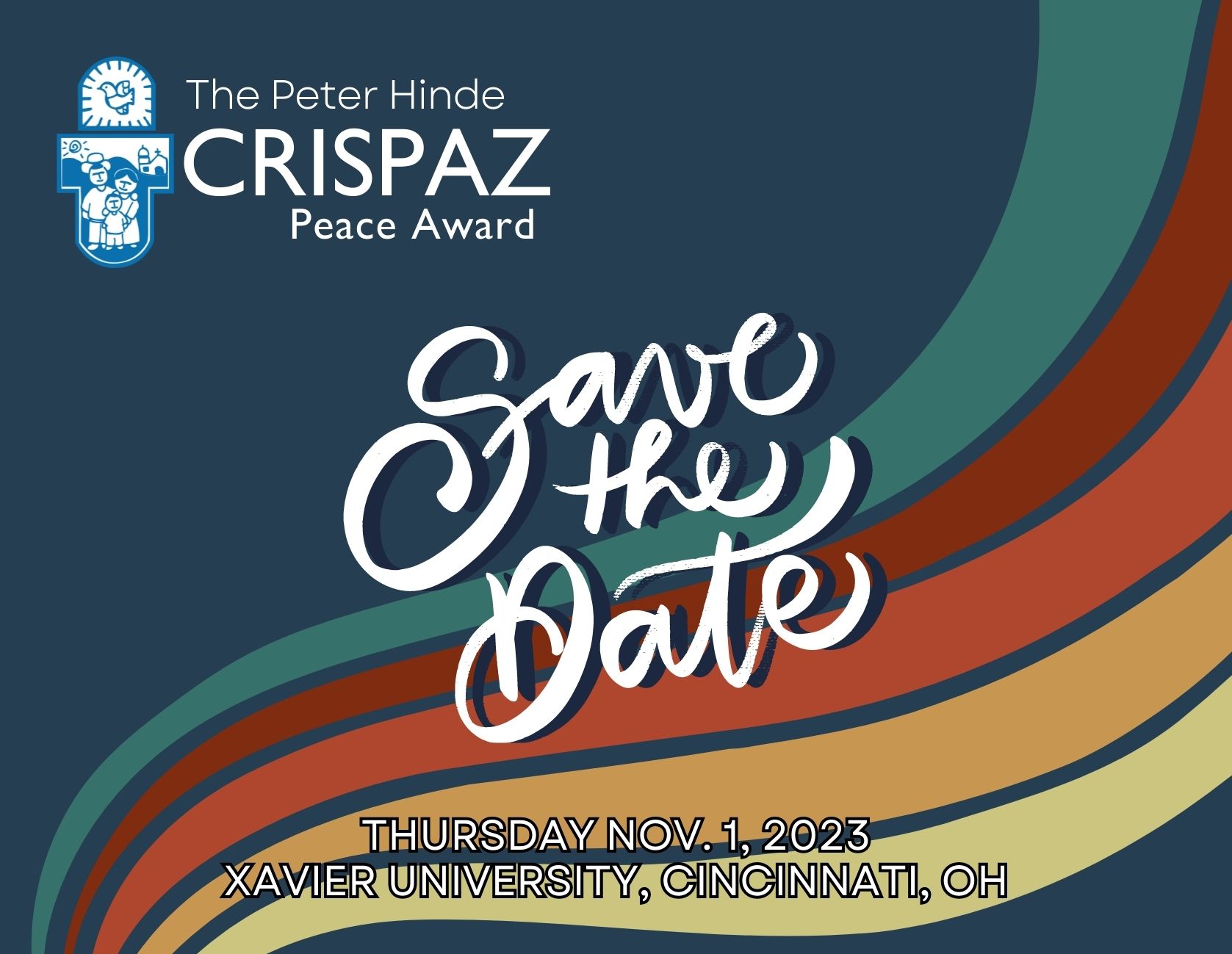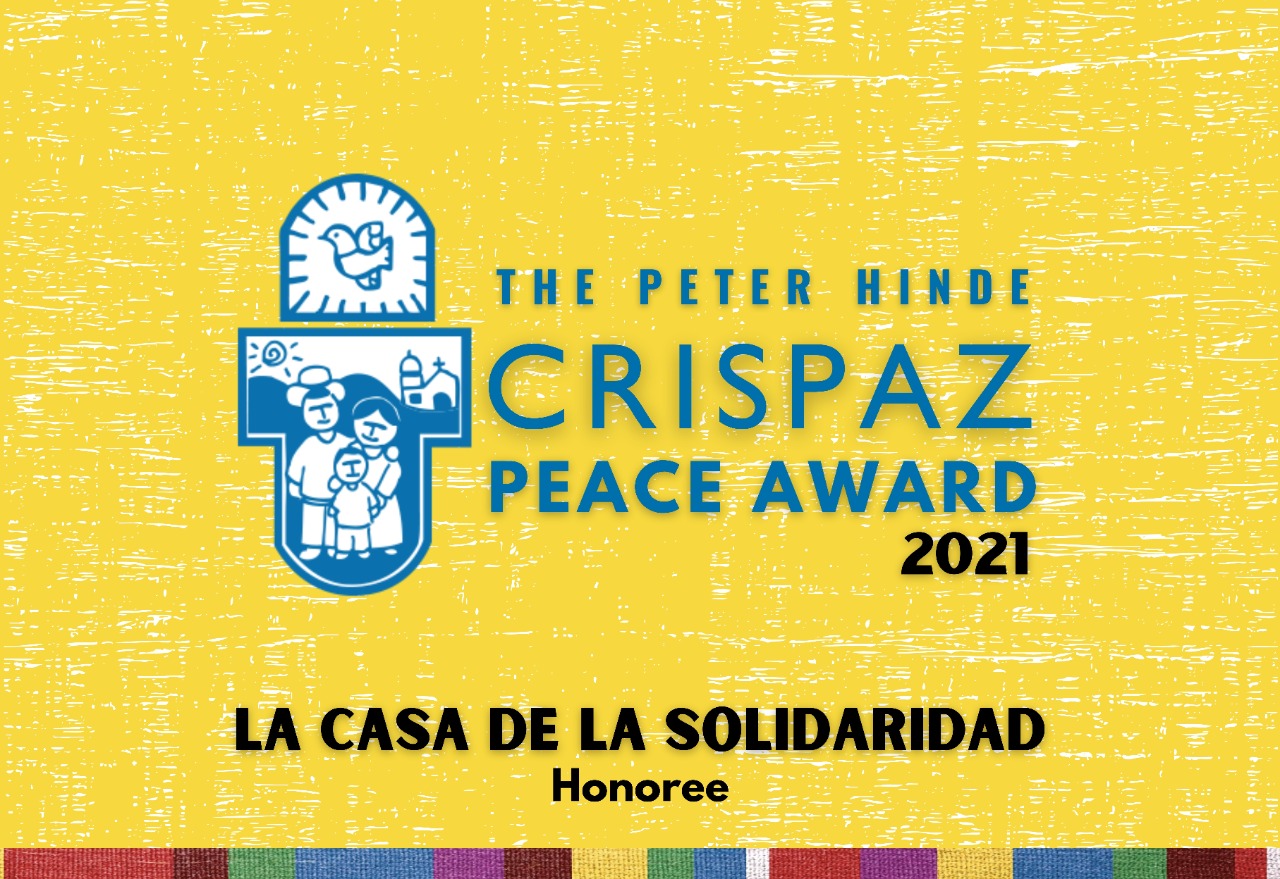CRISPAZ Peace Award



The 2023 PETER HINDE CRISPAZ PEACE AWARD
Cathy Cornell and Paul Knitter received the Peter Hinde CRISPAZ Peace Award 2023 for their adherence to nonviolent resistance in the accompaniment of the people of El Salvador.
The recognition event was held at Xavier University Conaton Board Room Schmidt Hall, 3800 Victory Parkway, Cincinnati, OH 45207 on Tuesday, November 1, 2023.
About The Award
Inspired by the testimony of the Martyrs of El Salvador, the CRISPAZ Peace Award was established in 2009 to recognize individuals or organizations that embody the preferential option for the poor in their work for the promotion of peace and social justice.
As of 2021, our annual peace award will henceforth be known as the Peter Hinde CRISPAZ Peace Award, in honor of our co-founder, Fr. Peter Joseph Hinde O. Carm. (1923-2020) and his lifelong commitment to peace and justice for the marginalized.



About Fr. Peter Hinde, o. Carm. (1923-2020)
His birth certificate and passport read “James J. Hinde, born in Elyria, OH,” as his Mom got off the train there to bring him to the light of day in a nearby hospital. Esther and Joe Hinde continued on to Sandusky from Cleveland to show their firstborn to grandparents. Travel would mark his future. Three sisters and a brother would follow him to round out the family, by that time living in Blue Island, a south suburb of Chicago.
He got off to a good start in baseball, thanks to his dad, and in his studies, thanks to the School Sisters of Notre Dame. At Mt. Carmel High, he was an excellent student and was named valedictorian of his class after working his way through school (1941). In his second year at Illinois Institute of Technology, he enlisted in the Army Air Force and was called up for active service in February 1943. He arrived on the island of Ie Shima, Okinawa, in late July 1945. On a mission to Seoul, Korea, his Squadron flew over Nagasaki three days after the atom bomb had been dropped there. He saw where the city had been, but for a brain-washed pilot at 15,000 ft, it was simply a casualty of war.
He was promoted to the rank of Captain in the Reserves after 3 1/2 years in the service, including 18 months of in the Pacific. During that time, he read a little book a chaplain had given him, “The Spiritual Exercises of St. Ignatius.” Reading it helped him decide to study for the priesthood.
In the Fall of 1946, he entered the Carmelite Seminary at Niagara Falls, Canada. In the novitiate, he was given the religious name Canisius. He did theology studies at the Carmelites’ Theology House in Washington, D.C., and was ordained in June 1952. After teaching for three years at Carmel High School and seminary, he went to Wolfnitz, in the Austrian mountains, for three years of contemplative life. Befriending fellow Carmelites who were German veterans from WWII, he began to break out of the shell of U.S. culture.
Three years later, while traveling through Europe, he met a young Japanese Catholic priest in Paris. Using Peter’s map and motorcycle, they teamed up to tour Paris, and then went by train to Lisieux, where St. Therese of Lisieux had lived and died. They began to share more deeply, and Peter discovered that, like him, his companion had been a fighter pilot, and that while he was in training, he had lost his whole family when the atom bomb was dropped on Hiroshima.
The two were stunned by the providence of their meeting. After a long silence, Peter said, “When we get to Lisieux, I will celebrate Mass in reparation for the atrocities of the U.S. military on your people.” His companion replied, “I will do the same, in reparation for the atrocities of the Japanese Armed Forces.” And so it was.
From 1960-65 Peter served as Master of Students at the Carmelite Theology House in Washington, D.C.. Peter and the students were soon caught up in the Black civil rights struggle. Peter considered this his second novitiate, as he began to see the deep structures of racism. It prepared him to see the structures of U.S. imperialism from the perspective of the victims: his friends.
Peter had been volunteering since 1958 to go to Peru and was finally sent there in 1965. His father died two months after his arrival. He flew back to Bradenton, Florida, to celebrate the funeral Mass with his mother and family. He stayed two weeks extra over Christmas with his mother. It was then that he studied the just-released documents of Vatican II. Returning to Lima, he taught Vatican II concepts in various forums and became involved with a group of progressive native clergy bent on social reform; Gustavo Gutierrez was one of them. In 1966 he joined the Carmelite mission in Sicuani, in the south sierra. There he was in charge of organizing missionary catechists for the rural Quechua communities.
In 1973 Peter and Mercy Sister Betty Campbell journeyed north, making contacts in Ecuador, Colombia, Panama, and Mexico on their way back to the U.S. In September 1973, just as the CIA-military repressive coup was taking place in Chile, they set up Tabor House, a Catholic Worker- type community in a poor barrio in northwest Washington, D.C. They were joined by Mercy Sister Mary Sears and Tadeo (Spike) Zywichi. Tabor had an anti-imperialist agenda, and did reverse mission work to evangelize the U.S. about negative U.S. influence in Latin America.
They immediately began to receive labor leaders and missionaries expelled from Chile and people who had been living on the streets and needed housing. They joined anti-war protests and initiated others in front of the embassies of U.S.-supported dictators in Latin America. Along with others, Peter and Betty invaded the White House and the IMF and were arrested and put on trial.
By 1975 the community had 25 members. It began the day with prayer and Mass. The contemplative rhythm of life made for deep reflection and analysis together. There was also a contemplative farm community outside the capital, which became a kind of retreat center. At Tabor, all members worked to cover expenses for food and rent. They dedicated half time to hospitality and half time to organizing protests. Peter was the principal contact person for outreach to allied institutions and activists; his prior experience in D.C. served them well.
In 1981, Tabor was closed, given that Peter and Betty were spending so much time in Central America, and so many Tabor members were working with refugees there. In 1983, Peter, Betty, and Spike opened Tabor in San Antonio, Texas, and in 1984 Dan Long invited Peter to join him in forming CRISPAZ, an NGO which brings delegations and volunteer workers to El Salvador.
During these decades, Peter and Betty have made frequent, lengthy trips to Central and South America to stay abreast of what’s happening there. Among many others, they’ve met with Bishop Julio Gerardi (later assassinated) at his Human Rights Office in Guatemala; Brazilian Bishop Pedro Casaldáliga, making a three-day retreat with him in Nicaragua during the Contra war; Cardinal Paolo Evaristo Arns, in Sao Paolo, Brazil; Jesuit Tercer Mundistists in Argentina; and Don Samuel Ruiz in Mexico, who briefed Peter and Betty after they arrived in Chiapas the week after the Zapatista uprising.
They closed Tabor in San Antonio on April 30, 1995, and opened Tabor in Juarez in September 1995, planning to spend their remaining years accompanying the Church and people south of the border. Carmelite Brother David Semmens joined Tabor in 2016. After working as a volunteer at a refugee center in El Paso, he accepted a chaplaincy at the El Paso Refugee Detention Center. Emilia Requena, a retired teacher, also joined Tabor, and works with the network of activist women.
Tabor received many delegations — one year they had 50 — but the 2008 depression combined with extreme violence in Juarez cut off all group visits. The recovery was slow, but by 2019 they had 39 delegations. Then, in March 2020, the Covid -19 plague shut down everything.
Peter had a light stroke in 2018. He recovered quickly but decided, at age 95, to stop celebrating Masses in public. He no longer attends the bi-weekly clergy meetings but stays in touch with pastors nearby. Additionally, he continued to participate with CRISPAZ and visit El Salvador once a year until 2019. In each visit, Peter’s charisma, love for people, and commitment to peace and justice were always present.
His recent passing due to complications from COVID-19 leaves a huge void, but at the same time offers us the gift of hope so we may continue his legacy.




Award Recipients

2023 : Cathy Cornell and Paul Knitter
For their adherence to nonviolent resistance in the accompaniment of the people of El Salvador.

2022 : Marie Dennis
For her work promoting peace through non-violence around the world.

2021 : La Casa De La Solidaridad
For its work in solidarity with Salvadoran communities from 1999 to 2017.
- 2023 Cathy Cornell & Paul Knitter for their tireless work in promoting peace through nonviolence in solidarity with the people of El Salvador.
- 2022 Marie Dennis for her witness and leadership in the commitment to nonviolence and promotion of dialogue.
- 2021 La Casa de la Solidaridad for their work in solidarity with Salvadoran communities from 1999 to 2017.
- 2020 Sr. Betty Campbell R.S.M. and Fr. Peter Hinde O.Carm (1923-2020) long-time peace activists.
- 2019 Jean Stokan and Scott Wright long-time peace activists.
- 2018 Fr. Jon Sobrino S.J. renowned Liberation Theologian and Professor since 1964 at The University of Central American in San Salvador.
- 2017 Fr. Paul Schindler Long-time missionary with Cleveland Mission Society in El Salvador
- 2016 Fr. Tom Smolich S.J. International Director of Jesuit Refugee Services
- 2015 Hospitalito The Carmelite sisters at the Divine Providence Chapel
- 2014 Asociacion ProBusqueda. Organization that investigates cases of the forced disappearances of children during El Salvador’s civil war.
- 2013 COFAMIDE The Salvadoran Committee of Relatives of Killed or Disappeared Migrants
- 2012 CoMadres Committee of Mothers and Relatives of Prisoners, the Disappeared and the Politically Assassinated of El Salvador
- 2011 Fr. Dean Brackley, S.J.† theology professor at the UCA, and pastoral minister to the rural community of Jayaque, La Libertad
- 2010 Sr. Peggy O’Neill director of the Art Center for Peace in Suchitoto
- 2009 Centro Monseñor Romero at the University of Central America (UCA)
